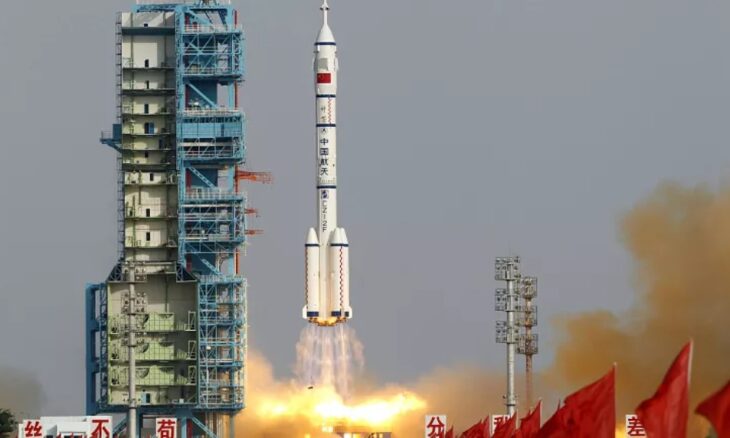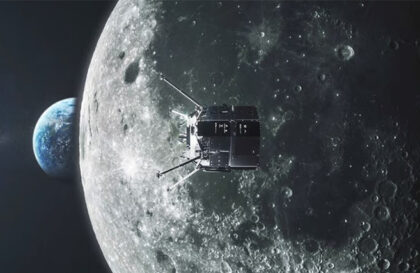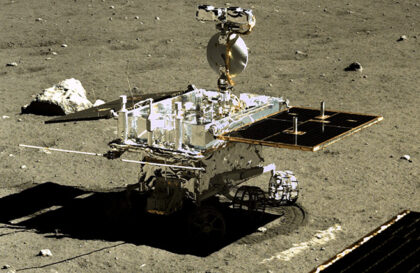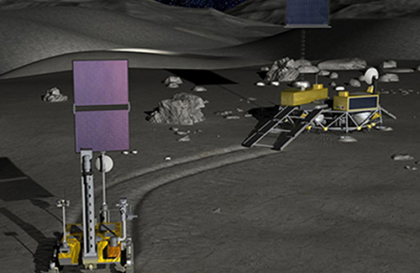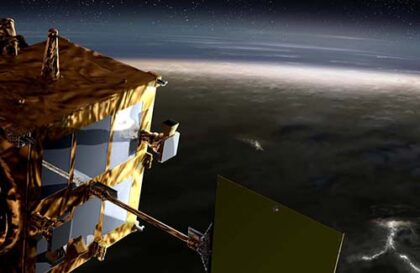On January 3, 2023, China marked four years since the Chang’e-4 probe’s successful lunar landing, remaining the only country to have landed on the Moon’s far side. The rover Yutu-2 is operational and has covered 1,455 meters on the Moon as of that date.
In 2023, China plans over 70 space launches, including crewed missions to the Tiangong space station and the re-launch of the Long March 5 rocket, whose mission is currently undisclosed. A low-orbit version of the same rocket will also be used for various purposes, possibly delivering a Hubble-like telescope.
China continues to expand its Earth observation capabilities with satellites like Yaogan, Gaofen, and Beidou and will launch communication, ocean monitoring, and weather satellites. Scientific missions include the Einstein Probe set for November 2023, and the Sino-French SVOM planned for mid-2023.
Graphic showing China’s Tiangong space station in orbit.
In 2022, China launched 64 rockets.
Let’s see how China achieved these results.
Infrastructure
China has an extensive network of scientific and industrial institutions in the space sector, including the China Aerospace Science and Technology Corporation (CASC), the China National Space Administration (CNSA), and the China Academy of Space Technology (CAST).
The country operates four space launch complexes: Jiuquan, Sichuan, Taiyuan, and Wenchang, which is the southernmost of them and is close to the equator, providing advantages for launching heavy and super-heavy rockets.
Additionally, China ranks third in the world in terms of the size of its space-monitoring ship fleet and has an extensive system of radar stations for tracking space objects. This system extends beyond the country’s borders, including posts in Namibia, Kiribati, and other states.
Chinese Orbital Constellation
As of February 2015, the number of satellites in China’s orbital constellation was 131, comparable to Russia’s orbital group.
The development of China’s space program in the 21st century is progressing dynamically. While only about 30 launches were conducted in the 1990s, since the beginning of the 2000s, China has sent over 100 spacecraft into orbit. Out of 147 satellites launched from 1970 to 2014, 87 were put into orbit in the first decade of the 21st century.
Modern Russia produces around 15 satellites annually, potentially increasing this number to 42. In comparison, China has over 500 satellites per year, and SpaceX can launch up to six satellites daily.
As of April 2022, China’s satellite constellation is the second-largest worldwide after the United States.
Number of satellites in orbit by major country as of April 30, 2022
History
China’s space program was founded by Qian Xuesen, who returned from the U.S. in 1955 after participating in American aerospace projects. The program began in 1956 with the creation of the 5th Academy of the Ministry of Defense and the first rocket launch carrying animals in 1966. In 1968, an aerospace medicine institute was established to train astronauts. China launched its first satellite on April 24, 1970, making it the 11th country with its satellite and the 2nd in Asia after Japan, which had launched its satellite just two months earlier.
In the 1990s, China used Ukrainian RD-120 engines to develop its rocket program. Since 1993, the program has been managed by the National Space Administration.
2003 the successful manned “Shenzhou” program (Project-921) was launched.
In 2018, China conducted 38 launches, surpassing the U.S. with 17 launches.
In the 2020s, China operates “Tianzhou” cargo ships with record payload capacity.
In 2021, the country launched several satellites and tested a reusable suborbital spacecraft.
The first Long March 8 launch, lifting off from Wenchang. Credit: CNSA
Staffed Program “Project 921”
This program has been crucial in transforming China into a significant space power.
“Project 921” consists of three stages:
921-1 — the development of a human-crewed spacecraft;
921-2 — the creation of visitable manned orbital laboratory stations, mastering docking technology;
921-3 — establishing a permanently manned, long-term multi-module orbital station complex.
921-1
Launched in 1992, Project 921-1 aimed to create the Chinese manned spacecraft “Shenzhou,” including four uncrewed and subsequent human-crewed missions. The first group of astronauts, drawn from military pilots, was formed in 1998, the second in 2010, and the third in 2020, including scientists and engineers.
Human-crewed missions began in 2003 by sending Yang Liwei into orbit aboard “Shenzhou-5.” “Shenzhou-6” 2005 became the first Chinese spacecraft with multiple crew members. 2008 the “Shenzhou-7” mission included China’s first extravehicular activity (spacewalk). In 2012, “Shenzhou-9” carried the first female taikonaut, and one of the taikonauts embarked on his second mission.
921-2
In 2011, China launched the “Tiangong-1” orbital laboratory to practice docking, with three expeditions visiting it (two of which were manned). In 2016, the launch of the “Tiangong-2” orbital laboratory followed, where technologies for the future space station were first tested.
Artist’s illustration showing China’s Tianzhou-1 freighter docking with the currently orbiting Tiangong-2 space lab. (Image credit: CMSE)
921-3
During 2021-2022, China was constructing its orbital station, weighing 60 tons with a life cycle of over ten years. The working volume of the station is 100 m³. It consists of three key modules and has a T-shaped configuration. The laboratory module “Wentian” features record-setting parameters for orbital spacecraft, including a robotic “arm” that measures 5 meters long and has 7 degrees of freedom.
The station will be operated by rotating crews of 3 or more taikonauts for 3-6 months. The orbit has an altitude of 340-450 km and an inclination of 42-43 degrees.
After the construction of the orbital station is completed, plans are to send an optical module named “Xuntian” to the same orbit, equipped with a space telescope featuring a two-meter mirror and enhanced image clarity.
China also plans to develop a new generation of carrier rockets and a human-crewed spacecraft capable of carrying seven astronauts, complete with a return capsule.
Banner image: Euronews with AP
Image credit:
https://www.euronews.com
https://room.eu.com
https://chinaspacereport.wordpress.com
https://www.statista.com
https://spacenews.com
https://www.space.com
